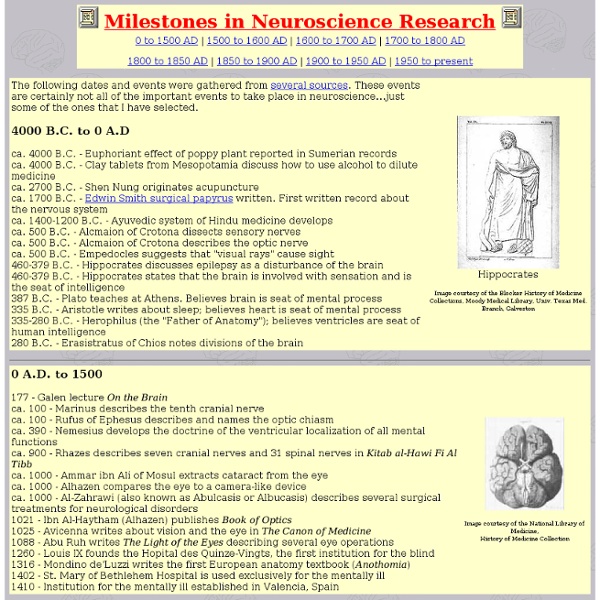



http://faculty.washington.edu/chudler/hist.html
Autism and Neuropsychology, by Marisa Marzillo Autism is a lifelong disorder that has become the discussion of many media outlets; it is a disorder that causes abnormal neurological development. It seems that lately autism prevalence is increasing, which is causing a demand for professionals to investigate on what causes autism. Autism disorder is characterized by different behavior including social impairments, difficulty in communication, and restrictive patterns of behavior. The neurobiology of politics What, if anything, should we make of studies that purport to find neurological differences between people who self-identify as "conservative" and people who self-identify as "liberal?" You've seen studies like that in the paper. You've heard them argued about on radio and TV shows. But what do they actually mean? Is this just so much high-tech phrenology?
The Human Brain - Stress Chronic over-secretion of stress hormones adversely affects brain function, especially memory. Too much cortisol can prevent the brain from laying down a new memory, or from accessing already existing memories. The renowned brain researcher, Robert M. Sapolsky, has shown that sustained stress can damage the hippocampus , the part of the limbic brain which is central to learning and memory. The culprits are "glucocorticoids," a class of steroid hormones secreted from the adrenal glands during stress. They are more commonly know as corticosteroids or cortisol . Neurological Control - Neurotransmitters - StumbleUpon Neurotransmitter Molecules Neurotransmitters can be broadly split into two groups – the ‘classical’, small molecule neurotransmitters and the relatively larger neuropeptide neurotransmitters. Within the category of small molecule neurotransmitters, the biogenic amines (dopamine, noradrenaline, serotonin and histamine) are often referred to as a discrete group because of their similarity in terms of their chemical properties. Click on the links in the table above to read more about some of the important neurotransmitters. Serotonin
Chapter 12: Attention and Consciousness Attention involves top-down (voluntary) goal-directed processes and bottom-up (reflexive), stimulus-driven mechanisms. They influence the way information is processed in the brain and can occur early during sensory processing. Balint's syndrome is a visual attention and awareness deficit. Someone who has this syndrome can only perceive one object at a time. Theoretical Models of AttentionAttention is defined as the ability to attend to somethings while ignoring others. There are three principle goals:To understand how attention enables and influences the detection, perception and encoding of stimulus events as well as the generation of actions based on the stimuli.To describe the computational processes and mechanisms that enable these effects.To uncover how these mechanisms are implemented in the brain's neuronal circuits and neural systems.
Dream facts Dreaming is one of the most mysterious experiences in our lives. During the Roman Era, some dreams were submitted to the Roman Senate for analysis and dream interpretation. They were thought to be messages from the gods. Sexual orientation – wired that way In a recent post, I presented the evidence that sexual preference is strongly influenced by genetic variation. Here, I discuss the neurobiological evidence that shows that the brains of homosexual men and women are wired differently from those of their heterosexual counterparts. First, we must consider the differences between the brains of heterosexual males and females. These differences are extensive and arise mainly due to the influence of testosterone during a critical period of early development (see Wired for Sex).
Cranial Nerves Can't remember the names of the cranial nerves? Here is a handy-dandy mnemonic for you: On Old Olympus Towering Top AFamous Vocal German Viewed Some Hops. The bold letters stand for: olfactory, optic, oculomotor, trochlear, trigeminal, abducens, facial, vestibulocochlear, glossopharyngeal, vagus, spinal accessory, hypoglossal. Still can't remember the cranial nerves? How Our Brains Make Memories Sitting at a sidewalk café in Montreal on a sunny morning, Karim Nader recalls the day eight years earlier when two planes slammed into the twin towers of the World Trade Center. He lights a cigarette and waves his hands in the air to sketch the scene. At the time of the attack, Nader was a postdoctoral researcher at New York University. He flipped the radio on while getting ready to go to work and heard the banter of the morning disc jockeys turn panicky as they related the events unfolding in Lower Manhattan. Nader ran to the roof of his apartment building, where he had a view of the towers less than two miles away.
The Brain—Information about the Brain 1 Introduction “I think, therefore I am.” —René Descartes, 17th-century philosopher Few of us question the crucial importance of the brain. It is vital to our existence. Our brains enable us to think, as René Descartes so skillfully pointed out nearly 400 years ago.
Neurostress: How Stress May Fuel Neurodegenerative Diseases In 2007, James Watson eyed his genome for the very first time. Through more than 50 years of scientific and technological advancement, Watson saw the chemical structure he once helped unravel now fused into a personal genetic landscape laid out before him. Yet there was a small stretch of nucleic acids on chromosome 19 that he preferred to leave uncovered, a region that coded the apolipoprotein E gene. APOE, as it’s called, has been a telling genetic landmark of Alzheimer’s risk, strongly correlated to the disease since the early 90s. Watson’s grandmother suffered from Alzheimer’s, and without any reasonable treatments or suitable preventive strategies, the father of DNA decided the information was too volatile, its revelation creating more potential harm than good.
The brain&s silent majority - 2009 FALL When you have no clue, call it glue. “Glia,” the Greek word for glue, was the name the pathologist Rudolph Virchow gave, back in 1856, to the gelatinous substance that forms the bulk of the brain. And it stuck. These days, scientists use it to denote the matter that accounts for 90 percent of the brain’s cells and more than half its volume — but, like the late comic Rodney Dangerfield, “can’t get no respect.”